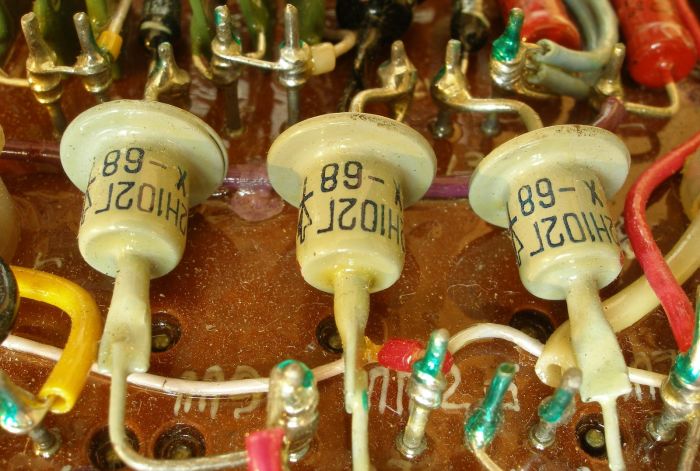Shockley diode on:
[Wikipedia]
[Google]
[Amazon]
 The Shockley diode (named after
The Shockley diode (named after

Unlike other semiconductor diodes, the Shockley diode has more than one p–n junction. The construction includes four sections of semiconductors placed alternately between the anode and cathode in the pattern of PNPN. Though it has multiple junctions, it is termed a diode for being a two-terminal device. The Shockley diode remains in an OFF state, with a very high resistance, until a voltage greater than the trigger voltage is applied across its terminals. When the voltage exceeds the trigger value, the resistance drops to an extremely low value and the device switches ON. The constituent

 Small-signal Shockley diodes are no longer manufactured, but the unidirectional thyristor breakover diode, also known as the dynistor, is a functionally equivalent power device. An early publication about dynistors was published in 1958. In 1988 the first dynistor using
Small-signal Shockley diodes are no longer manufactured, but the unidirectional thyristor breakover diode, also known as the dynistor, is a functionally equivalent power device. An early publication about dynistors was published in 1958. In 1988 the first dynistor using
Shockley diode analysis
Transistor Diodes, by Shockley himself (Jan. 1960)
Diodes Solid state switches {{Electronics-stub
 The Shockley diode (named after
The Shockley diode (named after William Shockley
William Bradford Shockley ( ; February 13, 1910 – August 12, 1989) was an American solid-state physicist, electrical engineer, and inventor. He was the manager of a research group at Bell Labs that included John Bardeen and Walter Houser Brat ...
) is a four-layer semiconductor
A semiconductor is a material with electrical conductivity between that of a conductor and an insulator. Its conductivity can be modified by adding impurities (" doping") to its crystal structure. When two regions with different doping level ...
diode
A diode is a two-Terminal (electronics), terminal electronic component that conducts electric current primarily in One-way traffic, one direction (asymmetric electrical conductance, conductance). It has low (ideally zero) Electrical resistance ...
. It is a PNPN diode with alternating layers of P-type and N-type material. It is equivalent to a thyristor
A thyristor (, from a combination of Greek language ''θύρα'', meaning "door" or "valve", and ''transistor'' ) is a solid-state semiconductor device which can be thought of as being a highly robust and switchable diode, allowing the passage ...
with a disconnected gate. Shockley diodes were manufactured and marketed by Shockley Semiconductor Laboratory
Shockley Semiconductor Laboratory, later known as Shockley Transistor Corporation, was a pioneering semiconductor developer founded by William Shockley, and funded by Beckman Instruments, Inc., in 1955. It was the first high technology compan ...
in the late 1950s. The Shockley diode has a negative resistance characteristic. It was largely superseded by the DIAC.
Working

Unlike other semiconductor diodes, the Shockley diode has more than one p–n junction. The construction includes four sections of semiconductors placed alternately between the anode and cathode in the pattern of PNPN. Though it has multiple junctions, it is termed a diode for being a two-terminal device. The Shockley diode remains in an OFF state, with a very high resistance, until a voltage greater than the trigger voltage is applied across its terminals. When the voltage exceeds the trigger value, the resistance drops to an extremely low value and the device switches ON. The constituent
transistors
A transistor is a semiconductor device used to Electronic amplifier, amplify or electronic switch, switch electrical signals and electric power, power. It is one of the basic building blocks of modern electronics. It is composed of semicondu ...
help in maintaining the ON and OFF states. Since the construction resembles a pair of interconnected bipolar transistors, one PNP and other NPN, neither transistor can turn ON until the other is turned ON due to the absence of any current through the base-emitter junction. Once sufficient voltage is applied and one of the transistors breaks down, it starts conducting and allows base current to flow through the other transistor, resulting in saturation of both the transistors, keeping both in ON state.
On reducing the voltage to a sufficiently low level, the current flowing becomes insufficient to maintain the transistor bias. Due to insufficient current, one of the transistors will cut off, interrupting the base current to the other transistor, hence sealing both transistors in the OFF state.
Usages
Common applications: * Trigger switch forsilicon controlled rectifier
A silicon controlled rectifier or semiconductor controlled rectifier (SCR) is a four-layer solid-state current-controlling device. The name "silicon controlled rectifier" is General Electric's trade name for a type of thyristor. The principle ...
* Relaxation oscillator / sawtooth oscillator
Niche applications:
* Audio amplifier
Typical values

Dynistor
 Small-signal Shockley diodes are no longer manufactured, but the unidirectional thyristor breakover diode, also known as the dynistor, is a functionally equivalent power device. An early publication about dynistors was published in 1958. In 1988 the first dynistor using
Small-signal Shockley diodes are no longer manufactured, but the unidirectional thyristor breakover diode, also known as the dynistor, is a functionally equivalent power device. An early publication about dynistors was published in 1958. In 1988 the first dynistor using silicon carbide
Silicon carbide (SiC), also known as carborundum (), is a hard chemical compound containing silicon and carbon. A wide bandgap semiconductor, it occurs in nature as the extremely rare mineral moissanite, but has been mass-produced as a powder a ...
was made. Dynistors can be used as switches in micro- and nanosecond power pulse generators.
References
* Michael Riordan and Lillian Hoddeson; ''Crystal Fire: The Invention of the Transistor and the Birth of the Information Age''. New York: Norton (1997) pbk.External links
Shockley diode analysis
Transistor Diodes, by Shockley himself (Jan. 1960)
Diodes Solid state switches {{Electronics-stub